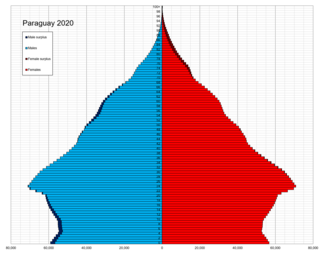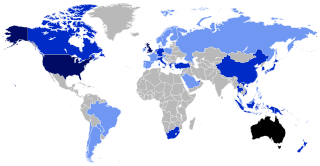
Demographic features of the population of Paraguay include population density, ethnicity, education level, health of the populace, economic status, religious affiliations and other aspects of the population.
Sudanese Australians are people of Sudanese origin or descent living in Australia. The largest population of Sudanese Australians reside in Victoria (6,085).

Welsh Australians are citizens of Australia whose ancestry originates in Wales.
Malaysian Australians refers to Malaysians who have migrated to Australia or Australian-born citizens who are of Malaysian descent. This may include Malaysian Chinese, Malays, Malaysian Indians, Orang Asal, mixed Malaysians and other groups.
Chilean Australians are Australians of Chilean descent or Chileans who have obtained Australian citizenship. Chileans are the second largest group of Hispanic and Latin American Australians residing in Australia. The biggest Chilean Australian communities are primarily found in Sydney, Melbourne and Canberra.

Australians, colloquially known as Aussies, are the citizens, nationals and individuals associated with the country of Australia. This connection may be residential, legal, historical or ethno-cultural. For most Australians, several of these connections exist and are collectively the source of their being Australian. Australian law does not provide for a racial or ethnic component of nationality, instead relying on citizenship as a legal status.
Samoan Australians refers to Australian citizens or residents who are of ethnic Samoan descent or people born in Samoa but grew up in Australia. However, there are many New Zealand-born Samoans living in Australia, known as Samoan New Zealand Australians. Most Samoans in Australia live in Sydney, Brisbane and Melbourne. Most people of Samoan heritage speak Samoan as their first language.

Egyptian Australians are Australian citizens and Australian permanent residents of Egyptian descent. According to the Australian 2011 Census, 36,532 Australian citizens and permanent residents declared that they were born in Egypt, while based on the 2006 Census, at least an additional 31,786 declared that they were of full or partial Egyptian ancestry and born in a country other than Egypt. The 2021 Census shows that the majority of Egypt-born Australians are located in Sydney (19,680) and Melbourne (13,312).
Hispanic and Latin American Australians refers to Australians who are of Hispanic, and/or Latin American origin irrespective of their ancestral backgrounds, and their descendants. Brazilian Australians make up the largest proportion of Hispanic and/or Latin American Australians, followed by Chilean Australians and Salvadoran Australians. Most Hispanic and Latin American Australians speak English but many continue to use Spanish or Portuguese as well.
Jordanian Australians refers to Australians of Jordanian descent or a Jordan-born person who resides in Australia. According to Australia's 2011 Census there were a total of 4,621 Jordan-born people in Australia, an increase of 24.2 per cent from the 2006 Census (3,397). The vast majority of Jordanian Australians reside in the state of New South Wales.

Uruguayan Australians refers to Australians of Uruguayan ancestry or birth who reside in Australia.
Afghan Australians are Australians tied to Afghanistan either by birth or by ancestry.

French Australians, some of whom refer to themselves as Huguenots, are Australian citizens or residents of French ancestry, or French-born people who reside in Australia. According to the 2011 Census, there were 110,399 people of French descent in Australia and 24,675 French-born people residing in the country at the time of the census, representing an increase of 28.6 percent compared to the 2006 Census. The largest French Australian community is in the state of New South Wales, where they number 8,936 people, many of whom reside in Sydney.

Ethiopian Australians are immigrants from Ethiopia to Australia and their descendants. However, as Ethiopia is a multi-ethnic country with significant inter-ethnic tensions, not all individuals from Ethiopia accept the label "Ethiopian", instead preferring to identify by their ethnic group. In particular, various Oromo people use the term 'Oromo Australian' instead. In contrast, there are many individuals who prefer to label themselves as Ethiopian Australians. This is because they oppose labelling themselves based on their ethnicity as they see it as divisive and politicising their ethnic identity. This is common among the Amharic-speaking community along with ethnically mixed individuals, compared to others who stand by their ethnic identity.
Caribbean Australians are people of Caribbean ancestry who are citizens of Australia.
Singaporean Australians are Australians of Singaporean descent. As Singapore is a multi-racial country, a Singaporean Australian could either be of Chinese, Malay or Indian descent, the main races of Singapore. According to the 2006 Australian census, 39,969 Australians were born in Singapore while 4,626 claimed Singaporean ancestry, either alone or with another ancestry.
Hong Kong Australians are Australian citizens or permanent residents of Hong Kong descent. Many Hong Kong Australians hold dual citizenship of Australia and Hong Kong.

Fijian Australians refers to Australian citizens or residents of Australia who are of ethnic iTaukei or Indian descent. Most Fijians Australians live in New South Wales (Sydney), Queensland (Brisbane) and Victoria (Melbourne).
Tongan Australians are Australians who are of ethnic Tongan descent or Tongans who hold Australian citizenship.
Nordic Australians are Australian citizens whose origins are found in any of the Nordic countries, or people from any of these countries who live in Australia. Danish immigrants made up the largest group by far.








